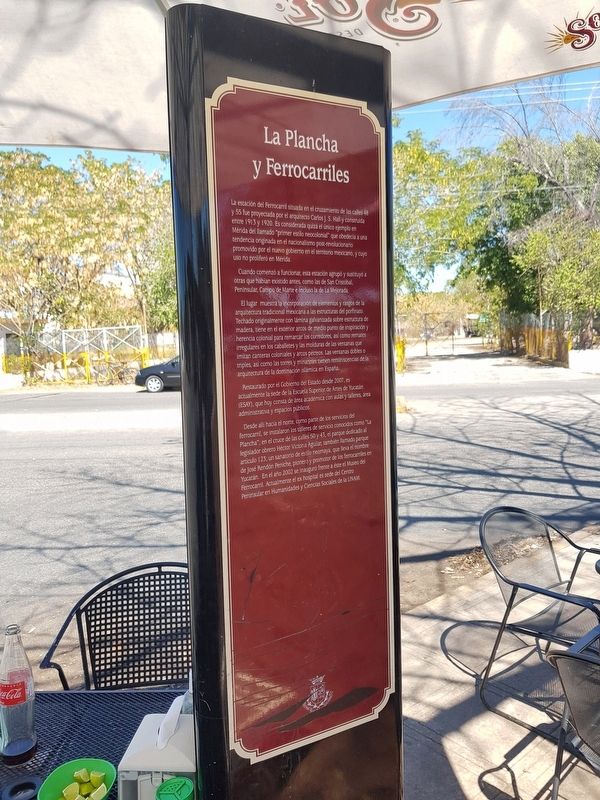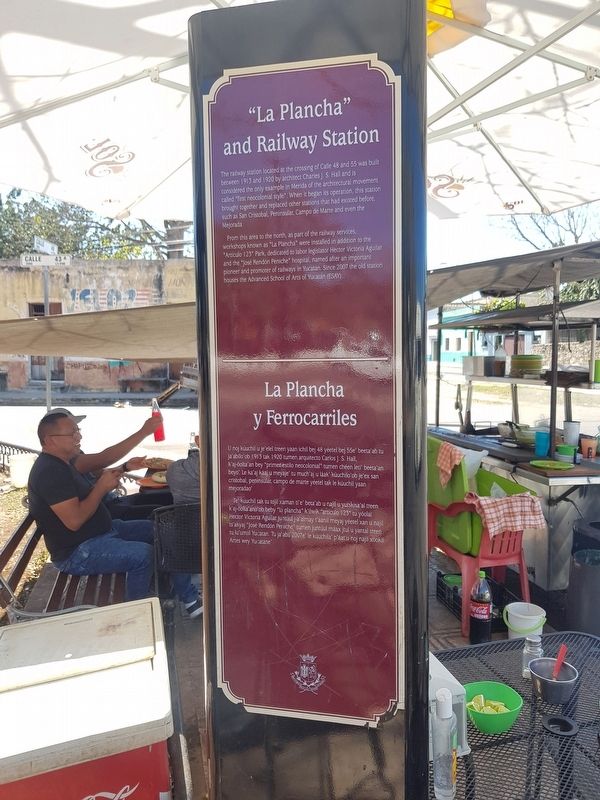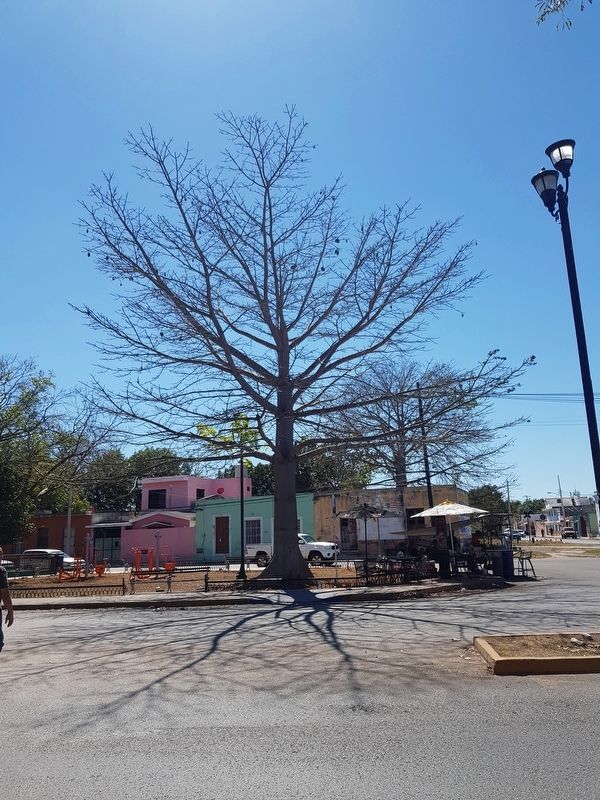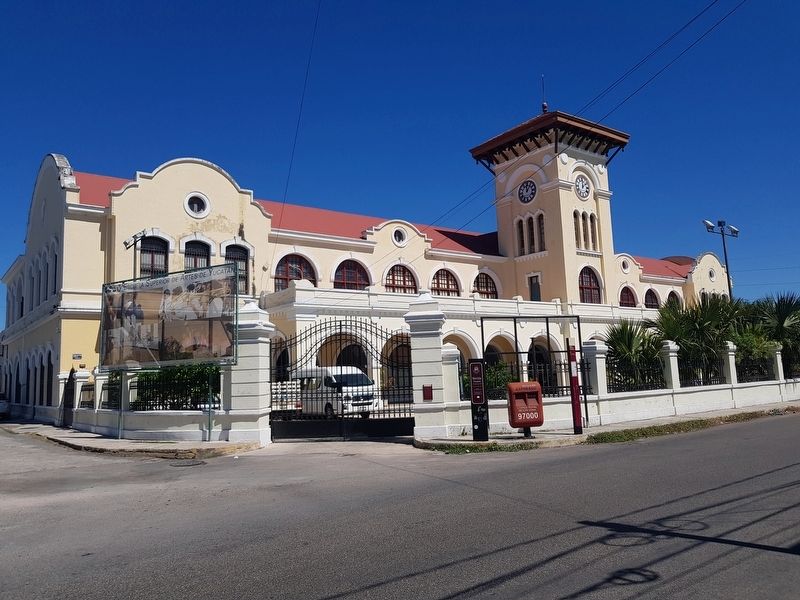Mérida, Yucatán, Mexico — The Southeast (Yucatan Peninsula)
"La Plancha" and Railway Station
Inscription.
La estación del Ferrocarril situada en el cruzamiento de las calles 48 y 55 fue proyectada por el arquitecto Carlos J.S. Hall y construida entre 1913 y 1920. Es considerada quizá el único ejemplo en Mérida del llamado "primer estilo neocolonial" que obedecía a una tendencia originada en el nacionalismo post-revolucionario promovido por el nuevo gobierno en el territorio mexicano, y cuyo uso no proliferó en Mérida.
Cuando comenzó a funcionar, esta estación agrupó y sustituyó a otras que habían existido antes, como las de San Cristóbal, Peninsular, Campo de Marte e incluso la de La Mejorada.
El lugar muestra la incorporación de elementos y rasgos de la arquitectura tradicional mexicana a las estructuras del porfiriato. Techado originalmente con lámina galvanizada sobre estructura de madera, tiene en el exterior arcos de medio punto de inspiración y herencia colonial para remarcar los corredores, así como remates irregulares en los caballetes y las molduras de las ventanas que imitan canteras coloniales y arcos pétreos. Las ventanas dobles o triples, así como las torres y minaretes tienen reminiscencias de la arquitectura de la dominación islámica en España.
Restaurado por el Gobierno del Estado desde 2007, es actualmente la sede de la Escuela Superior de Artes de Yucatán (ESAY), que hoy consta de área académica con aulas y talleres, área administrativa y espacios públicos.
Desde allí hacía el norte, como parte de los servicios del ferrocarril, se instalaron los talleres de servicio conocidos como “La Plancha”, en el cruce de las calles 50 y 43, el parque dedicado al legislador obrero Héctor Victoria Aguilar, también llamado parque articulo 123; un sanatorio de estilo neomaya, que lleva el nombre de José Rendón Peniche, pionero y promotor de los ferrocarriles en Yucatán. En el año 2002 se inauguró frente a éste el Museo del Ferrocarril. Actualmente el ex hospital es sede del Centro Peninsular en Humanidades y Ciencias Sociales de la UNAM.
“La Plancha” and Railway Station
The railway station located at the crossing of Calle 48 and 55 was built between 1913 and 1920 by architect Charles J. S. Hall and is considered the only example in Merida of the architectural movement called "first neocolonial style". When it began its operation, this station brought together and replaced other stations that had existed before, such as San Cristobal, Peninsular, Campo de Marte and even the Mejorada.
From
this area to the north, as part of the railway services workshops known as "La Plancha" were installed in addition to the “Articulo 123” Park, dedicated to labor legislator Hector Victoria Aguilar and the "José Rendón Peniche" hospital, named after an important
pioneer and promoter of railways in Yucatan. Since 2007 the old station houses the Advanced School of Arts of Yucatan (ESAY).
La Plancha y Ferrocarriles
U noj kúuchil u je'elel treen yaan ichil bej 48 yéetel bej 55e' beeta'ab tu ja'abilo'ob 1913 tak 1920 tumen arquitecto Carlos J.S. Hall, k'ajóolta'an bey "primer estilo neocolonial" tumen chéen leti beeta'an beyo: Le ka'aj káaj u meyaje' tu much'aj u láak' kúuchilo'ob je'ex san cristobal, peninsular, campo de marte yéetel tak le kúuchil yaan mejoradao’.
Te' kúuchil tak tu tojl xaman tie' beta ab u nail u yutskisa' al treen k’a-óolta’ ano'ob beby "la plancha" k’ilwik "articulo 123" tu yóolal Hector Victoria Aguilar juntúul j-a'almay t'aanil meyaj yéetel xan u najil ts'akyaj "José Rendón Peniche" tumen juntúul máax jtul u yantal treen tu lu'umil Yucatan. Tu ja'abil 2007e' le kúuchila' p'áat Artes wey Yucatane”.
Topics. This historical marker is listed in these topic lists: Industry & Commerce • Railroads & Streetcars. A significant historical year for this entry is 1913.
Location. 20° 58.592′
N, 89° 36.775′ W. Marker is in Mérida, Yucatán. Marker is at the intersection of Calle 43 and Calle 48, on the left when traveling east on Calle 43. Touch for map. Marker is in this post office area: Mérida YU 97000, Mexico. Touch for directions.
Other nearby markers. At least 8 other markers are within walking distance of this marker. Héctor Victoria Aguilar (within shouting distance of this marker); José Rendón Peniche (within shouting distance of this marker); Diesel Electric Locomotive F.U.S 412 (about 90 meters away, measured in a direct line); Passenger Car 4285 (about 90 meters away); Steam Locomotive (about 90 meters away); Diesel Electric Locomotive S-BC 2201 (about 120 meters away); Passenger Car 1552 (about 120 meters away); The Old Rendón Peniche Sanitorium (about 180 meters away). Touch for a list and map of all markers in Mérida.
Credits. This page was last revised on October 14, 2022. It was originally submitted on March 10, 2019, by J. Makali Bruton of Accra, Ghana. This page has been viewed 146 times since then and 11 times this year. Photos: 1, 2, 3, 4. submitted on March 10, 2019, by J. Makali Bruton of Accra, Ghana.



